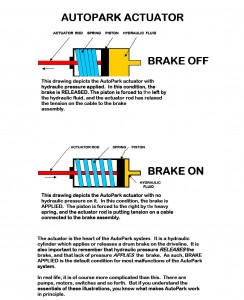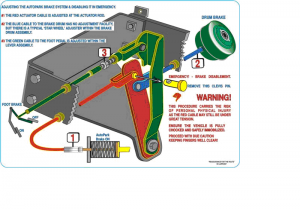Understanding Auto Park parking brake actuator shaft travel
This subject is often misunderstood. We’ll try to explain it in a manner that makes sense.
It is important to understand that the parking brake drum system on an AutoPark parking brake equipped chassis is designed as a STATIC SYSTEM. This means that it is NOT an emergency brake. It is NOT designed to stop a vehicle that is already rolling. It IS designed to keep a vehicle from rolling once it has been stopped by the service brakes.
As such, the parking brake shoes should THEORETICALLY never experience any wear. In actual practice though, they may occasion some wear due to malfunction of the AutoPark parking brake feature (brake gets applied while you are going down the road), OR – – On a chassis that includes a manual means of applying the parking brake (such as a foot pedal or lever), someone has mistakenly driven the vehicle while the manual brake was applied.
Barring one of the two above scenarios, the lining in the parking brake should last indefinitely. A rare exception would be if the rear seal in the transmission leaks, and soaks the brake shoes with ATF. This will require replacement of the shoes regardless of their wear condition.
A “companion” write up that goes along with this one you are reading, is titled “How It Works.” In that write up, there is a picture (with annotations) of an AutoPark parking brake with the drum removed. You can see the shoes, levers, springs etc. Having that write up in front of you as you read this document, will help you to understand the principles involved.
Below is an illustration of the actuator in both the BRAKE ON and the BRAKE OFF conditions.
Click on image to enlarge
These two illustrations to left show the “limits” of the actuator shaft/piston travel. For purposes of this part of the discussion, we will assume that the actuator is on a bench-top, and not mechanically connected to the brake drum.
In the upper drawing, the hydraulic pressure has totally compressed the big spring in the actuator. As such, the actuator shaft has moved as far to the left as possible. This is a fixed, mechanical limitation. The big spring will not compress any farther, so the actuator shaft as well cannot move any farther..
In the lower picture, with no hydraulic pressure in the cylinder, the piston/shaft will move all the way to the right. (For purposes of this illustration, ignore the small amount of fluid shown in front of the piston. In actual practice, the piston would “bottom out” if the actuator was not mechanically connected to the brake system). Again, another fixed and mechanical limitation. We would estimate that the total travel between these two limits would be about 2.5 inches. If/when the piston does bottom out, or approaches bottoming out, we call that condition “Over travel.”
We now have our very own actuator with which we can do tests and make measurements. Additional information is based on what we can lift from the manuals we have, as well as what we have extracted from our history and experience with AutoPark parking brake systems – – about a ten year adventure. Consequently, some of the dimensions we will be using are going to be approximations. While not perfect, they will be well within the limits of accuracy needed to explain the workings of the system.
Let’s examine the photo included in the “How It Works” write up. This backing plate and brake shoe assembly is purposely designed such that the top end of the lever must move about one inch to the left in order to properly set the brake. This one inch of travel is predicated upon the shoe lining being in good shape, and having the star wheel adjuster set to the point where the shoes would not quite touch the drum – – in the BRAKE RELEASED condition. If the shoes are worn down, or the star wheel adjustment is “too loose,” then the lever travel will be more than one inch. Not desirable.
Another important detail: If you follow the cable from the parking brake drum, it does NOT go directly to the actuator. Instead, it is connected to a mechanical device called “The Lever Relay.” Below, is an illustration of this assembly. Note that this version shown also includes a foot pedal, but this feature is only found on earlier year models. For purposes of this discussion, it is only the red lever setup that we need to be concerned with.
Click on image to enlarge
This illustration shows how the configuration of the red lever affects the cable movement. The geometry of this setup is such that if the blue cable moves about an inch, the red cable will move about an inch and a quarter. This is important to remember in any discussion of actuator travel.
SUMMARY: For this parking brake system to function properly, you must start with good brake shoes which are properly adjusted. This establishes the desirable one inch of travel that the lever must make in the brake drum assembly. If there is MORE than one inch of travel at that point, you cannot properly compensate for it by changing cable adjustments or some other parameter in the system.
As the cable travel is transmitted through the lever relay, the one inch of movement (between BRAKE ON, and BRAKE OFF), is increased to one and one quarter inches. This is due strictly to the lever geometry – – it is a fixed ratio of about 1.25 to 1.0.
So – – Assuming the cables themselves are in good condition, this leaves our remaining variable to be the long hex nut on the actuator shaft – – depicted as #1 in the illustration above. It is very important to note that this actuator is shown in the BRAKE ON condition – – TRY TO VISUALIZE IT WITH THE SPRING COMPRESSED in the BRAKE OFF condition. With the brake OFF and the actuator shaft extended to its mechanical limit, we would want to adjust the long hex nut just to the point where there was no slack in the cable system – – no more, no less. If we then remove the hydraulic pressure from the actuator, the spring will expand, and the piston and shaft will move to the right – – applying the brake. This means that the brake lever in the drum will move about an inch, the cable going to the lever relay will go about the same inch, the cable going FROM the relay to the actuator will move about 1.25 inches, and the actuator shaft will move into the actuator (to the right as viewed in the picture), about 1.25 inches. Since the TOTAL travel of a disconnected actuator is about 2.0 inches, this means that we will have a “preload” on the big spring of about .75 inches. In other words, if one were to cut the cable under the BRAKE ON condition, the actuator shaft would snap back into the actuator an additional .75 inches. It is this preload that makes it somewhat difficult and dangerous to disconnect the cable at the lever relay clevis while the cable is under this preload tension. You will notice a warning to that effect in the illustration above.
The point of this entire exercise, is to show that you need good brake shoes and good cables, all properly adjusted, as a prerequisite to any successful repair of the AutoPark parking brake system. The whole concept of achieving 1.25 to 1.50 inches of total actuator travel (between BRAKE ON, and BRAKE OFF), is critical to successful operation of the actuator and understanding how it relates to the parking brake setup.
If you DON’T start with that 1.25 to 1.50 of travel, you will likely have either a brake that is dragging or a brake that doesn’t hold. No amount of monkey-fudging with other adjustments is likely to cure the problem.
Comments or questions are always welcomed oldusedbear
Download the complete PDF; Understanding Auto Park parking brake actuator shaft travel here






